Images bring local history to life and without them it would be a very dull subject. Drawings, paintings and photographs have been used to record the passing of time in the Falkirk district for centuries. They depict places, people, and events. Those images contemporaneous with the period that they record contain much incidental information and give us a better idea of what life was like than the sanitised reconstructions. This is particularly so with photographs which capture whatever is in front of the camera.
Photography was seen as one of the scientific marvels of the mid-nineteenth century in much the same way as moving pictures were at the beginning of the 20th century. Prior to its introduction the only way to record a reasonable likeness of a person or place was through an artist and that was a slow and expensive process restricted to the upper classes. David Octavius Hill of Edinburgh was one of the Scottish pioneers of the photographic process and did much to popularise the medium. He was also a painter and produced paintings of the Edinburgh and Glasgow Railway in the 1840s, including one of Falkirk High Station. Photography was also seen as an art with a balanced composition and correct lighting as two important elements.
From the large cities like Edinburgh and Glasgow a profusion of small businesses spread out to the provincial towns of Scotland. At first these tended to be travelling firms operating as showmen and indeed often travelled with the performing shows. By 1860 one of the chief places of amusement in the town of Falkirk was the open space in front of the Corn Exchange which became Newmarket Street. Here were to be found shows of different kinds, such as merry-go-rounds, not driven by steam but by hand. In June 1861 Miller’s Photographic Studio travelled from Glasgow and set up in Mr Graham’s garden opposite the Corn Exchange for a period of eleven weeks. The novelty of the product attracted much attention. For the Studio, the target audience was the Volunteer movement. These patriotic men had conscientiously taken up arms in potential defence of their country. They had donned uniforms, drilled and voluntarily given of their valuable time, but now that the emergency had passed rumours abounded that they were to be stood down. Each proud unit and each uniformed man was therefore a potential customer for the photographer. This was the first time in the history of the nation that such an army had the opportunity to be recorded for posterity. Portraits were in vogue as family history. Miller’s studio was probably a wooden-framed tent and here the developing and printing took place. Natural daylight was needed for the taking of the photograph.
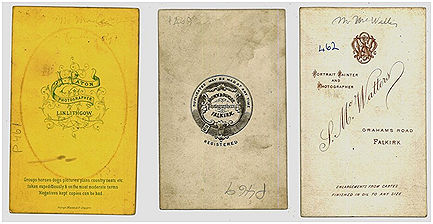
At the time there were no buildings fronting the north side of Newmarket Street – except for the brewery at the west end. The area was occupied by the fields of the glebe. Seeing a potential market for the new-fangled pictures, Messrs Brown and Dunlop erected a wooden hut here in 1864 for use as a photographic gallery and opened up for business in April that year. The open fields meant that there were no adjacent buildings to overshadow them, which at that time was essential. As a result they promised to produce “pictures of the softest and most artistic character.” They produced “carte portraits” at 8s per dozen.
The small portrait mounted on card, measuring around 6cm by 12cm, known as a carte de visite, was the trendy thing to have for the upper and middle classes – hence why they were not simply called “visiting cards.” Brown and Dunlop also produced four acres of potatoes on the glebe.
Brown and Dunlop were not the first permanent professional photographers to set up business in Falkirk. That honour goes to a local painter called Stewart McWatters. He is listed as a painter in the 1846 subscription list to pay for the lighting of the dial of the clock on the Steeple using gas. He contributed 10s 6d and was evidently a man of some substance. He had been involved with the local campaigns to support the Reform Act which was finally passed in 1832 and remained a keen supporter of further reform. A veteran of the ’32, his shop in Grahamston was decorated for the third Reform Act of 1884 with an oil painting above the door of the hero of the moment – Gladstone. Red banners were draped on either side. Stewart McWatters set up business as a photographer in Grahams Road in 1858 using a glass house or greenhouse, 18ft by 8ft in size, as his studio. Half the sides and roof were of timber. This was put up for sale in May 1863 when he upgraded his premises, as he boasted in his advert:
“Stewart McWatters has now to intimate that, for the purpose of carrying out the requirements of the art, he has just finished the erection of a large and commodious NEW GLASS STUDIO, thoroughly ventilated and lighted on the newest principles, which he is confident will enable him to produce pictures of a much superior class than he has hitherto been able to do in his old studio; and for comfort of parties favouring him with their commands he is sure there is not a better arrangement in Scotland. He has also added to his other improvements that of waiting and dressing-rooms. These arrangements coupled with using the purest chemicals, and the most improved cameras, he flatters himself that those patronising him will not be disappointed – the more especially for those beautiful little pictures, carte de visites, of which he has done some thousands during the past twelve months, the price of which is 2s 6d for first copy, and 10d each for after copies.”
(Falkirk Herald 21 May 1863).
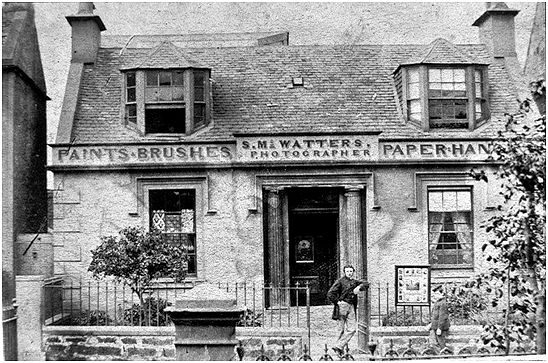
The comparatively youthful age of the proprietor suggests that this photograph dates to 1864 after his improvements. The new studio can just be seen extending above the roof of the house. The uniformed boy was presumably an employee.
Apart from Brown and Dunlop, the only other local competition on the horizon was James Paton of Dunfermline who in July 1867 opened a studio opposite the railway station in Linlithgow. This took away part of the trade from the east end of the district, particularly in Muiravonside, but had little overall impact.
The artistic merit of the photographs was stressed time and time again. Studios vied with each other for scenic backdrops and by the mid-1860s “action shots” were being recreated. Uniformed volunteers, armed and unarmed, stood to attention. Captain Nimmo was photographed by Stewart McWatters in 1865, but now there was a move for animation. Dunlop and Brown were keen curlers and found that there was a demand for photographs of men curling. The unpredictability of the weather and the type of photographic equipment made in impracticable to shoot them outside and so the duo recreated the scenes inside. Veterans of the roaring game were attired as if for a frosty day on the ice and photographed on a reflective surface complete with curling stones and cowe. The result was described as “exquisitely lifelike.” Also stressed was the likeness – which today we expect from a photograph but which with the primitive materials available at the time was not taken for granted.
The 1860s also saw the use of photographs as official records. When the barque “The Kingdom of Fife” was launched and fitted out at Grangemouth by Messrs Adamson, that company hired Messrs Brown and Dunlop to photograph it. On 15 October 1864 Brown went to the Old Dock where she was berthed and captured the vessel the day before she sailed for Hartlepool.
“that artist succeeded in taking an admirable likeness not only of the barque but also of a considerable number of gentlemen connected with the Port, who were on the poop, top-gallant, forecastle, and on the quay in the immediate vicinity”
(Falkirk Herald 20 October 1864, 3).
The photograph was subsequently displayed at their studio.
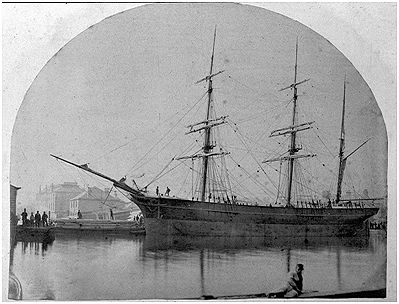

In April 1868 Brown and Dunlop also made a record of the Roman distance tablet that had just been discovered at Bridgeness and the public were able to buy copies from their studio or from Waldie’s bookshop in Linlithgow. The following month they were asked by the Procurator Fiscal to photograph the scene of a boiler explosion in Bo’ness.
Local industry was thriving and this created a demand for portraits by the entrepreneurs and their rising workforce of middle management and craftsmen. Stewart McWatters was commissioned to capture “an excellent likeness” of R W Kennard MP, the owner of Falkirk Ironworks, who gave him a sitting during a visit to the district in 1865 (Falkirk Herald 31 August 1865, 2). At the same time the opportunity was taken to photograph a group of the office staff at the Falkirk Ironworks. George Binnie, the manager of the works, is seen standing in the position of honour in the centre of the front row. In the background is the main entrance to the foundry which, despite its grandiose architectural design, has moulding equipment tastefully littered in front of it.
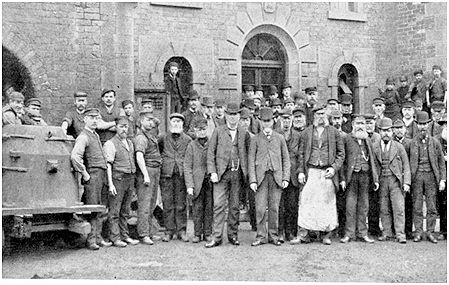
With greater competition and better equipment the prices of photographs were reduced making them more widely available. In April 1864 Stewart M’Watters advertised the following services and prices:
Carte de visite, full length, 8s per dozen; second dozen, 6s; vignette, light background for bust, no extra charge. Bust on fine ornamental card, 6s per dozen; second dozen, 5s.
Rembrandt carte, which style cannot be surpassed for bust portraits, for boldness and roundness of effect – also without any extra charge.
Rings, brooches, lockets, and all kind of jewellery fitted with portraits.
Notice – carte portraits from negative, taken previous to the 1st of March, may be had at reduced charge of 6s per dozen.
Copying of all kinds done at moderate charges. A good variety of stereoscopic slides, 6d each, or 5s per dozen.
It was important for the photographers to keep up with changes in fashion as well as technology. In May 1868 Stewart McWatters announced that he was adding the painting of the photographic portraits in oil to his repertoire,
“so much practised in cities – the combination of the two arts producing that truthfulness and colour which all desiring a true likeness of themselves or friends cannot fail to appreciate.”
(Falkirk Herald 21 May 1868, 4). In this he was going back to his own roots.
Stewart McWatters was also one of the first to show pictures in Falkirk using a magic lantern. In 1870 he did a presentation to the Band of Hope featuring slides bought in to tell the parable of the Prodigal Son. Such lantern slide performances became a familiar event in the following decades and the professional photographers such as Thomas Greig kindly operated the equipment at evening talks. Greig went one step further: in 1893 he used a powerful lantern to place colours around the actors at a kinderspiel play in Bonnybridge (Falkirk Herald 30 December 1893, 6).
The success of James Paton’s studio in Linlithgow encouraged him to expand to Falkirk and in January 1877 he opened a new one at South Pleasance, Falkirk. The location, outside the town centre, was apparently deliberate and he stated that it had the advantage of having better light, in part due to it being removed from the smoke. Paton visited Falkirk on Mondays, Thursdays, and Saturdays. In April that year the firm of Brown and Dunlop came to an end and James Dunlop set up on his own. For the occasion he leased premises at the Garrison, on the corner of Vicar Street and McFarlane Crescent.

In his opening announcement Dunlop says that the building was specially erected as a photographic studio and was naturally equipped with all of the latest improvements and appliances. More importantly he was able to show that he too was keeping pace with the new technology, having
“made arrangements with M. LAMBERT, Rue de Londres, Paris, whereby he has secured the sole right of using in the Falkirk district his Marvellous patent processes termed LAMBERTYPE, CONTRETYPE, & CHROMOTYPE PERMANENT PHOTOGRAPHY. The pictures produced by this process are superior to the best Silver Prints, both as regards Artistic Effect and Softness, besides possessing the long-wished-for advantage of undergoing no change, either through adverse atmospheric influence or time, and may be obtained on equally favourable terms as those by the existing method. They are also peculiarly applicable for Enlarging and Finishing Instantaneous Pictures of Children in a superior manner; also for Copying, Enlarging, and Improving Old, Faded, and Inferior Photographs of Deceased Relatives and Friends.”
Like McWatters he did enlarged photographs in oil.
One of his most important statements in that initial advert was that
“The whole of the Negatives (amounting to many thousands) taken since Brown & Dunlop commenced business have been carefully kept, and Enlarged Portraits of Deceased Friends can be had from these by the above New Permanent Process, and Finished in Oil by First-class Artistes”
(Falkirk Herald 21 April 1877, 2).
This ensured customer loyalty and became standard practice in the trade. When photographic businesses changed hands the new management acquired the goodwill of the old along with the all-important negatives. Upon the retirement of James Dunlop in 1886 Andrew Brown bought the goodwill and negatives. This should have ensured the longevity of the images but it did not. Inevitably many of the businesses eventually closed without any direct successor and the negatives were disposed of. It is ironic that the bulk of the photographs in the present day Falkirk Archives come from amateurs and Council staff (particularly the Museum and Planning Department) and not the professional photographers.

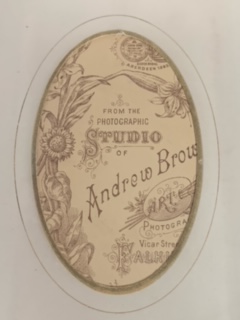
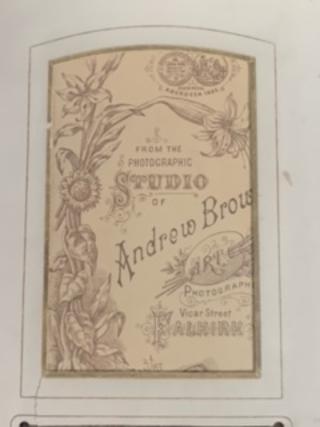
The Garrison Studio had a long life and was used by a succession of gifted photographers:
| James Dunlop | 1877-1884 |
| A Luckhaus | 1884 |
| Charles Mitchell | 1885-1891 |
| Thomas Greig | 1891-1896 |
| John Simpson | 1896-1902 |
Dunlop moved to Vicar Street in 1884 and his successor at the Garrison Studio was August Luckhaus. He continued with the popular cartes de visite. As a publicity stunt he offered to photograph the town council of Falkirk free of charge. The councillors naturally considered that he would not find a more handsome group of men anywhere in the district and readily agreed. The year was a momentous one for it witnessed the huge demonstrations in support of Gladstone’s Reform Act and Luckhaus saw another opportunity. He issued a series of thirteen large photographs giving views of the Franchise demonstrations in Falkirk. The weather on the day had been unfavourable but the images still managed to capture the moment. Two stood out – one in Newmarket Street and one at the 1871 Gentleman Fountain; only the former survives.
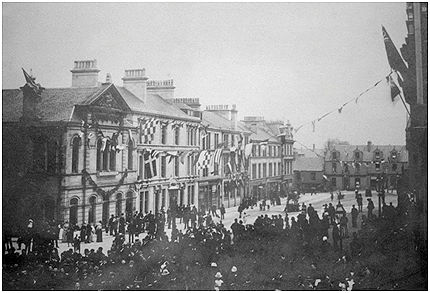
By then, what had formerly been a potato field on the north side of Newmarket Street where Brown and Dunlop had erected their wooden studio was an elegant terrace of halls and shops erected by the Glebe Building Company. The last of these was the Christian Institute in 1881. This photograph is one of the earliest street views that we have of the town.
Luckhaus sent a set of the views to William Gladstone and received in reply the following letter:
10 Downing Street, Whitehall, 7th October, 1884.
Sir, – Mr Gladstone desires me to thank you for the photographs which you have so kindly sent him. From what he saw elsewhere in Scotland of the feeling of the people in relation to the present crisis, he can well believe that the demonstration at Falkirk was marked by all the enthusiasm you describe in your note. I am Sir, your most obedient servant, E.W. Hamilton.
(Falkirk Herald 11 October 1884, 2).
Unfortunately, Luckhaus was not lucky and in December 1884 a fire broke out in the chemical department of the Garrison Studio. Upwards of 1,000 negatives were destroyed, together with the total destruction of several very valuable paintings. The Falkirk Fire Brigade was able to confine the flames to that portion of the building, though equally as much damage was done to the property by the water used (Falkirk Herald 20 December 1884, 2). The damage done was covered by insurance but Luckhaus decided to emigrate to America and soon set up a studio in Indiana. He died there in 1913 aged 57 years.
Despite increasing competition amongst photographers, three of those in the town of Falkirk fell in line with the move amongst retailers in 1886 to close early on Wednesday afternoons. A notice was duly published in the local newspaper:
“We, the undersigned photographers in Falkirk and Grahamston, have resolved to close our places of business on Wednesdays, at 2 o’clock.
C. Mitchell, Garrison Studio
A. Brown, Vicar Street
A. Forsyth, Grahams Road”
(Falkirk Herald 11 December 1886, 1).
The next occupant of the Garrison Studio was Charles Mitchell who had a successful photographic business in Forfar. Although he travelled to his Falkirk branch to oversee the work, much of the day to day operation was undertaken J Aitken, including the photography. Mitchell ran the business in Falkirk from 1885 until 1891, when he was succeeded by Thomas Greig.
Greig used the Garrison Studio from 1891 to 1896 and was very popular. He too helped amateur dramatic groups and societies of all kinds with lantern slides, stereoscopic views and lighting. Whilst the Garrison Studio was convenient for the railway station it was a little too close. The heavier and more frequent trains caused a noticeable vibration which was not conducive to good photography. So, in 1896 Greig moved to the Old Manse Studio which he had
“specially built and fitted up with most modern appliances, and will be free from the vibration that of late in the Garrison Studio has proved so annoying to both sitter and operator alike.”
(Falkirk Herald 11 April 1896).
Two years later he advertised in the newspaper for a “garden, whole or part, suitable to erect small glass-house for photographic printing.” Subsequently ex-Bailie Christie, Fernielea, applied for and was granted permission to erect a photographic printing studio in Bell’s Wynd for Mr Greig.
In the 1890s the use of flash-light photography became more common and allowed interior photographs to be taken at events. John Simpson worked from the Garrison studio from 1896 and was in the vanguard of this development in the Falkirk area. He even used it in the Garrison Studio in the winter months when the natural light was poor – compensating for the vibrations that so annoyed Greig as they only required shorter exposures. This was particularly useful in the lead up to Christmas when people thought about buying a portrait for a Christmas gift. Simpson was able to remain open until 9pm in the lead up to Christmas using the latest system of flashlight, promising that the clients would be surprised at the results which were considered to be equal to daylight. As a special purchase the photograph could be mounted on a Christmas card.
At the end of 1902 Simpson was forced to find premises elsewhere as the Garrison Studio was demolished as part of the improvements to Vicar Street which saw the much disliked footbridge over the railway replaced by a wide road bridge. He moved to 76 High Street which he appropriately called the Coronation Studio.
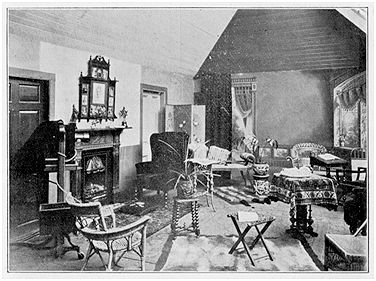
Meanwhile Andrew Brown had taken over Dunlop’s studio in Vicar Street and was in turn followed by his brother Joseph C Brown. Usually known as either J.C. Brown or J. Collier Brown, he became one of the most widely known of the Falkirk photographers because like Greig he was associated with many of the local societies. His photographs appear in many of the publications printed at the turn of the century at a time when this medium was taking off. Often these publications were in support of fundraising efforts for churches. In return J C Brown got wholesome praise and copious advertising. The 1896 programme for the Town Mission bazaar is particularly noteworthy and as well as giving an illustration of the interior of the Studio it provides quite a lot of background information which it is useful to reproduce as it shows what was considered important at the time:
“The well-appointed studio we present here is that of Mr J.C. Brown. The most casual observer cannot fail to realise that it obtains to a person of taste, and if proof were wanting of Mr Brown’s ability to manipulate the camera, and the mysterious apparatus of the dark room, we need only say that the pictures on our pages, except the few otherwise acknowledged, are from his hands. Nay! We had almost said they came from his heart as well; for the Artist loves his work, and has laboured willingly for the Town Mission Bazaar.
Having fallen into a “Brown Study,” let us say that the subject of this notice comes of a well-known family of Aberdeenshire, artists and photographers. His father was on many occasions, summoned by Lord Aberdeen and Lord Kintore, to photograph interesting house parties of Royal and other distinguished visitors, such as Gladstone, Bright, and Stanley. Many choice bits of rural scenery on the Dee and the Don came in for his attention, and when the boys grew up, they had already developed the artistic eye on studies such gems of Scottish scenery, as those glens “where Gadie rins” and where the Ury winds dreamily round the “Back o’ Benachie.”
Coming of such antecedents, there need be no surprise at Mr Brown taking a leading place here; his brother Mr. Andrew Brown (whom we in Falkirk know well), doing the same in Aberdeen, and the third worthily filling his father’s place in Inverurie.”
J Collier Brown also published a book of his own called “Views of Falkirk & District”. It is just that, with no commentary or description. Although not dated, the sixteen photographs show the town before the advent of the trams in 1905. The view looking north along Vicar Street has the Studio on the right hand side with the sign “A. Brown, photographer” prominently displayed. In front of this is the glasshouse/shed so typical of the photographic firms. These buildings, stretching all of the way from the Argyll Bar (later the site of Princes Street) to the British Linen Bank were demolished in 1903 and Vicar’s Chambers was built incorporating the Grand Theatre. The new buildings were set back on the line of those seen in the foreground of the photograph (the Parochial Buildings) so that the street could be widened. Note the shadowy figure on the left of the photograph who has been erased to provide better balance.

Not all of the photographers of this period were following a family tradition. John Simpson had served an apprenticeship with Dunlop the baker before entering Springfield Foundry and rising to the position of manager there. In 1896 he decided to follow his hobby and take up photography as a profession, moving to the Garrison Studio. However, when he died in 1902 at the early age of 46, his son was expected to carry on the business.
The equipment steadily improved over the years but it did not always work as it was intended to and a remarkable accident occurred in April 1935 when Peter Baird was taking a flashlight photograph at Bothkennar during the performance of the Dramatic Club. Baird had taken three pictures and was on the point of taking a fourth when the trigger on the flash gun jammed. As he examined it, the powder exploded and flashed in his face. He sustained extensive burning injury to his eyes and face and had to be treated in Falkirk and District Royal Infirmary (Falkirk Herald 20 April 1935, 9).
Peter C Baird was one of the first press photographers in the district. Born in Laurieston, he served an apprenticeship with Cochrane the chemist in Grangemouth before setting up as a photographic chemist in Denny in 1929. Two years later he decided to work freelance as a press photographer and was a familiar sight at Brockville. Through his constant contacts with people he became well-known. At the beginning of the Second World War he volunteered to work as a pharmacist in the Royal Army Medical Corps but contracted a tropical decease whilst working as a dispenser at the British General Hospital in Palestine. He died on 3 March 1944. His photographs had often been printed in the Falkirk Herald.
For the first fifty years of its production the Falkirk Herald rarely used photographs. As printing methods improved, such images were slowly incorporated into its pages in the first decade of the 20th century. This process was accelerated by the First World War when portraits of many of those who had been killed in service were given prominence. These photographs were not taken by or for the newspaper but serve as a strong reminder of the role that the portraits played in remembrance. The young men were proudly recorded in their uniforms and the photographs were retained and cherished by their families. Indeed, they contributed to the cost of placing them in the Herald.
Grangemouth became a garrison town at the beginning of the First World War and the local photographer there, RGD Hood, was often commissioned to take group photographs of the various units stationed there. Before long, however, Hood was called up. It was February 1919 before he had the pleasure of intimating in the local newspaper that “he has now been demobilised from the Army, and will resume business on Monday, 24th inst.” In May the following year he presented the Grangemouth Bowling Club with a roll of honour bearing 16 individual photographs of its members who had served with the forces during the war, two of whom were killed on duty.
After the war the Falkirk Herald employed professional photographers to record local news in their images – everything from fires and floods to amateur dramatics and weddings. Throughout the 1930s these photographers also took memorable pictures of the district which were printed for their own sake without any story attached as a record of daily life. These started as plate glass negatives before moving onto modern film. We are fortunate that many of these survived and are now in the care of the Falkirk Archives at Callendar House.
Between the world wars women entered into the photographic business with both Margaret Hunter and Annie MacLachlan operating from Grahams Road. They specialised in children’s portraits. When Annie retired in 1950 her successor was Stanley Bloch who many still remember. He had grown up in Merchiston Avenue and won several photographic competitions. He had worked for several companies, including the Scottish Studios and Engravers in Glasgow and had become the staff cameraman for Publicity Designs of Coventry. Like most of the photographers upon taking possession of an established studio he took over the negative collection and revamped the premises. He offered:
“Ultra-speed flash “candid camera coverage” of functions, dances, etc, at request. Weddings in the studio, at the reception or church. Other services include processing, printing, first-grade enlarging, colouring, mounting, framing and camera repairs”
(Falkirk Herald 22 February 1950, 1).
His photographs were technically proficient and he became well known for his stills of industrial products as well as the interiors of works. In 1951 a set of his photographs of Castlelaurie Works was on display in the Industrial Section of the Festival of Britain. Racing pigeons were popular in the 1950s and Bloch photographed the best. The shop window was used to present exhibitions of photographs and in October 1953 it featured these birds, attracting much attention from the pigeon fanciers of the area. He died of a heart attack when visiting the Tank Farm at Kinneil Kerse in 1981.
The windows of the photographic studios had always been used for display – and not just photographs. James Dunlop exhibited two paintings by the famous artist Edward Henry Holder in 1883. These were “Craig Dinas Mill” and “near Bettws-y-Coed, North Wales.” It was a local artist, James W Davie, who RGD Hood promoted at his studio in 1922 and for several years thereafter. Davie was the art master at Grangemouth High School and his etchings and paintings were widely known. It was also useful to place newsworthy items in the windows, such as the Ambulance Shield won by the No. 1 Grangemouth L.M.S. Railway team in 1931.
The professional photographers also exhibited their own work beyond the confines of their studios. The first exhibition of the Grangemouth Amateur Photographic Association in Grangemouth Town Hall was held in 1902 and Hood had a display at it. The principal exhibitors were amateurs in the craft, but professional businessmen – Rev Robert Hamilton, Dr M’Gowan, Dr Paterson, R Marshall, Mr Maryon, Mr J P Mackenzie, Mr William Farquhar, etc. Like Luckhaus, Hood also got a letter from the prime minister of the day. Whilst on holiday on the Moray Firth in September 1935 Hood had photographed a glorious sunset. He later sent a copy to Sir Louis Greig whom he knew from the Flying Corps during the war. Greig thought it so good that he sent a copy to Ramsay Macdonald who wrote:
“Dear Mr Hood, When I returned to London I found that Sir Louis Greig had left a photograph for me, which I think is one of the most beautiful pieces of photography that I have ever seen. I am very glad to possess it, and congratulate you upon your handiwork. The subject, of course, makes it specially attractive for me, but quite apart from that it is a very artistic piece of work…”
(Falkirk Herald 6 February 1935, 6).
Macdonald had been brought up in Lossiemouth.
Robert Gourlay Dick Hood was a native of Glasgow and came to Grangemouth in his early 20s. He took over a studio at the north end of Lumley Street near Charing Cross. The building was a wooden two-storey building with large display windows and roof lights to let plenty of light into it. It was a prime location and in 1905 the British Linen Bank offered to buy the site at a good price. Hood moved his studio to 12 Talbot Street – literally. The wooden building was jacked up and placed on a temporary frame or trolley. Then, on a quiet Sunday morning, it was pulled along the street to the new site just around the corner. Three heavy horses were used for the purpose. The new site was next to the Drill Hall. The bank constructed a handsome red sandstone building on the old site which opened in March 1906 and is still there.
Robert Gourlay Dick Hood was a native of Glasgow and came to Grangemouth in his early 20s. He took over a studio at the north end of Lumley Street near Charing Cross. The building was a wooden two-storey building with large display windows and roof lights to let plenty of light into it. It was a prime location and in 1905 the British Linen Bank offered to buy the site at a good price. Hood moved his studio to 12 Talbot Street – literally. The wooden building was jacked up and placed on a temporary frame or trolley. Then, on a quiet Sunday morning, it was pulled along the street to the new site just around the corner. Three heavy horses were used for the purpose. The new site was next to the Drill Hall. The bank constructed a handsome red sandstone building on the old site which opened in March 1906 and is still there.
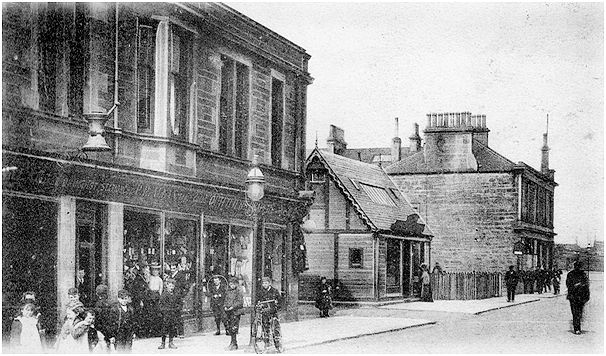
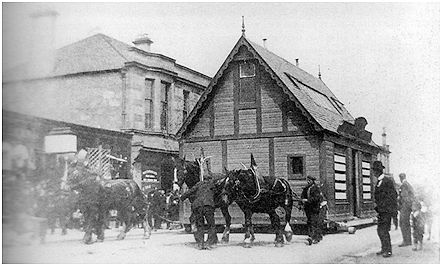
Hood’s premises were very close to those of the Grangemouth Co-operative Society and they came to an unusual arrangement whereby members of the Co-op could be supplied with purchase orders on the Society’s account – a useful thing when it came to the dividend!
The timber building used by Hood was typical of many of the studios but there was obviously an increased risk of devastating fires. We have already mentioned that of 1884 at the Garrison which was timeously dealt with by the fire brigade, but W D Hunter at Denny was not so fortunate:
“PHOTOGRAPHIC STUDIO BURNED DOWN. About 10pm on Wednesday fire was discovered to have broken out at the studio of Mr W D Hunter watchmaker. The Studio, which was a wooden erection, with corrugated iron roofing, is situated in the garden ground to the rear of the west side of the Main Street, and only a few yards from the wood yard of Mr Baxter, joiner, Duke Street. Fortunately, however, there was little or no breeze or the effect of this conflagration would have been disastrous to the entire neighbourhood… The whole of the operating apparatus in connection with the studio has been totally destroyed, including two valuable lenses, a large camera, and eight drop scenes. The damage, which is estimated at fully £100, is partly covered by insurance.”
(Falkirk Herald FH 19 August 1905, 5).
Hood was succeeded at his Talbot Street premises by R McVey in November 1947. A native of Dalry in Ayrshire he had formerly been on Government service in Hong Kong for 12 years and had been interned by the Japanese for three and a half years, being released in August 1945. As was normal practice, the new owner revamped the studio to keep up to date with the latest technology and fashion:
“He has installed a glass-enclosed battery of mercury-vapour and other lamps which have been specially constructed after his own design to give complete colour balance on a picture. They require very short exposures – useful for children. A modelling light can be used to throw a beam from the side for greater relief. A background unit with various interchangeable parts provides a variety of backcloths. Central heating has been installed, and there is a dressing-room, dark-room and workshop. In the darkroom are modern developing tanks. Floating lids exclude air from the developing fluid and make it last longer, while an electric immersion heater is employed to bring it to the right temperature. A special darkroom for prints has a cascade washer consisting of three semi-circular tanks ascending in series like steps. The prints are kept in motion by water bubbling from below and the lack of corners reduces chances of the prints sticking to each other. A new enlarger works perpendicularly. Light switch operated by foot. Special swinging metronome. Large filing system. Three girls help with re-touching photos. Freckles can be removed. Special pencils are applied to the negative held up to the light in glass panels and can take up to 2 hours. Glossy finish done by a glazing machine with a curved sheet of heated chromium.”
(Grangemouth Advertiser 21 May 1949).
Many of the studios employed staff to help with the various tasks. For the front of the house respectable girls straight from school were favoured. Such girls were also employed printing and for the retouching of the negatives – removing facial blemishes and the like. In order to get extra trade people were hired to go to the remoter villages and tout for business. They were known as “canvassers” and although usually men some women were employed. A short notice in the Falkirk Herald to the effect that the canvasser was working for a particular photographer was useful. One canvasser was found guilty in 1905 of taking money in Standburn under false pretences. He received 2s 6d as a deposit for family photographs claiming to be working for Thomas Greig, which he was not.
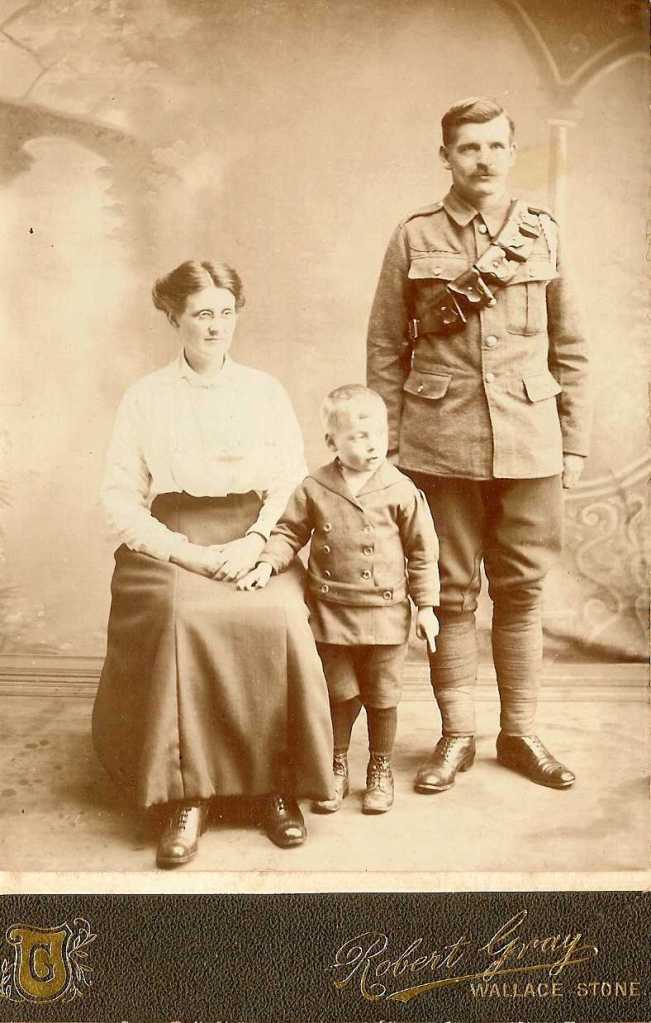
These outlying villages often had their own part-time professional photographers. As the communities that they served were quite small they were well known there and did not need to advertise in the local press. Consequently they are less visible in the written record. Robert Gray is a good example. He served the people of the Avonbridge area in the first two decades of the 20th century – taking portraits and “manipulating” the magic lanterns at talks. Some of his marked photographs survive but he is not found in the printed adverts or directories of the time. He operated his photographic studios as additional income – his principal occupation being a coal miner.
.
The Second World War saw a repeat of many of the conditions imposed by the Great War. Film was scarce and amateurs dared not shoot scenes in close proximity to military establishments. Seaside snaps on the beaches of the Forth were strictly forbidden. Most of Annie McLachlan’s custom during the war was portraits of local soldiers on leave or going to join their units. There were also passport photos and wedding groups. The glass roof to her studio had to be painted over as part of the black-out precautions and so most portraits were taken in the early afternoon. Sadie Riggs worked as a re-toucher, touching up photographic prints, for JC Brown. She was an experienced hand, having done this job for some five years. She also acted as the receptionist and recalled that the firm remained busy throughout the war. The studio was a large wooden shed with skylights to the north. JC Brown’s son, Robert, also worked in the studio and was slowly taking over from his father.
In peaceful times many of the professional photographers also sold equipment and supplies for the amateurs to use – cameras, film, paper, chemicals and so on. We are fortunate in having had some very gifted amateur photographers such as Thomas Easton, Telfor Drummond and JP Munn, but that is a story for another time.
List of Professional Photographers in the Falkirk Area:
| ASTBURY, Tom | 1978-1982 | Falkirk Museum |
| BAIRD, Peter C | 1929-1931 1931-1939 | Photographic chemist, Burlington Bldgs, Stirling St, Denny Press Photographer |
| BLOCH, Stanley | 1950-1981 | The Studio, 44a Grahams Rd, Falkirk |
| British Rapidograph Co | 1907 | 6 Bank St, Falkirk |
| BROWN, Andrew | 1886-1897 | 15 Vicars St, Falkirk |
| BROWN, J Collier | 1897- 1950s | 15 Vicar St, Falkirk The Studio, 37 Vicar St, Falkirk |
| BROWN, William R | 1914 | Larbert |
| BROWN and DUNLOP | 1864-1877 | Newmarket St, Falkirk |
| BURNS, James C and Co | 1920s | 9 The Hedges, Camelon 115 North St, Bo’ness |
| CLARK, Andrew B | 1888-1910s | Railway Station, Linlithgow |
| COOPER and DURIE | 1900s-1910s | 18 Newington Rd, Edinburgh & George Pl, Bo’ness |
| DICKSON, A A | 1940s-1950s | Coronation Gallery, 76 High St, Falkirk |
| DOHERTY, John | 1890s | Red Tiles, Carriden Brae, Bo’ness |
| DRENNAN, Alexander DRENNAN & Sons | 1960s | 20 Grahams Rd, Falkirk Falkirk & Leven |
| DUFTON, Alex | 1890s-1910s | Corner of East Pier St, Bo’ness |
| DUNLOP, James | 1877-1886 | Garrison Studio, Vicar St, Falkirk 15 Vicar St, Falkirk |
| FAIRWEATHER, Wm | 1950s | Bo’ness |
| Falkirk Herald | 125 High St, Falkirk | |
| FLEMING, John | 1900s | Avonbridge |
| FORSYTH, Alexander | 1885 | 90/92 Grahams Rd, Grahamston |
| FORSYTH, James J | 1910-1921 | Denny |
| FOWLER, J | 1890s | Slamannan |
| GARRETT, Robert | High St, Linlithgow | |
| GRAY, Robert | 1900s-1920s | Avonbridge & Wallacestone |
| GREIG, Thomas | 1880s-c1918 | Garrison Studio, Garrison Pl, then Old Manse Studio, Manse Pl (sometimes described as being in Vicars Street) then Coronation Studio, 76 High St, Falkirk. Day and Light Studio, Coronation Gallery |
| HOOD, Robert G D | 1900s-1947 | Grange Studio, Lumley St, Grangemouth 12 Talbot Street Branch at 99 North St, Bo’ness |
| HUNTER, Margaret | 1950s | 2 Grahamsdyke St, Laurieston 85 Grahams Rd, Falkirk The Studio, 44A Grahams Rd, Falkirk |
| JOHNSTON, M & W | 1890s | Melville St, Falkirk |
| LUCKHAUS, August | 1884 | Garrison Studio, Vicar St, Falkirk |
| LYALL, William J | 1910s-1933 | Larbert |
| MacLACHLAN, Douglas | 1910s-1926 | 36 Grahams Rd, Falkirk Main St, Camelon (emigrated to Canada) |
| MacLACHLAN, Annie H | 1927-1950 | The Studio, 44A Grahams Rd, Falkirk |
| MacLAREN, John | Larbert | |
| McVEY, R | 1951 | 12 Talbot St, Grangemouth |
| McWATTERS, Stuart | 1850s-1892 | The Glass House, 92 Grahams Rd, Falkirk |
| MILLAR, James P | 1902-1933 | West End Studio, 8 West Bridge St, Falkirk |
| MILLER, George | 1920s | Bo’ness |
| MILLER,Holloway | 1910s-c1920 | 6 Vicar St, Falkirk |
| MITCHELL, Charles | 1885-1904 | Garrison Studio, Garrison Pl, Falkirk Also had a studio at 48 East High St, Forfar |
| MORRISON, J George | 1910-1914 | Dunfermline 30 Grahams Rd, Falkirk 34 Grahams Rd, Falkirk |
| MURRAY, F R | 1900s | The Studio, Larbert |
| MUSER, John G | 1899-1908 | Allan Bank Studio, Stenhousemuir |
| PATON, John | 1860s-1890 1876-1879 | Railway Station, Linlithgow South Pleasance, Falkirk |
| PERRY, George | 1920s | Denny |
| PHILLIP, A | 1900s-1920s | Bo’ness |
| RAMSAY, A L | 1900s | Falkirk |
| RAMSAY, Thomas R | 1949 | 216 Main Street, Camelon |
| REID, George | 1910s-1920s? | Denny |
| RENNIE, Thomas L | 1950s | 95a Wallace Street, Falkirk |
| RODGER | 1920s | Campfield St, Falkirk |
| RODINSON, T C | 1880s | 234 Sauchiehall Street, Glasgow Imperial Studio, Melville St, Falkirk |
| RUSSELL, W | 1900 | Airth? |
| SIMPSON, John | 1896-1902 1902-1906 | Garrison Studio, Falkirk Coronation Studio, 76 High St, Falkirk |
| SMART, Archibald | 1910s-1922 | 115 North St, Bo’ness |
| SNEDDON, James | 1930s | 12 Orchard Street, Falkirk |
| STEWART, George | c1900 | 44 Grahams Rd, Falkirk and 5 High St Kirkcaldy and 271 Sauchiehall St, Glasgow |
| TAYLOR, A & G | 1890s | Grahams Rd, Falkirk |
| THOM, R B | 1910s-1920s | Bo’ness |
| TURNBULL, T W | 1900s | Electric Studio, Falkirk |
| WALKER, Alexander | 1882 | Larbert |
| WALKER, Edwin J | 1880s-90s | Larbert Arnothill Gdns, Falkirk |
| WAUGH, Robert | 1900s | Irwin Pl, Dennyloanhead |
| WELSH, William | 1902-1910s | Springfield Studio, Bonnybridge |
| YOUNG, Abraham | c1890s | Falkirk |

